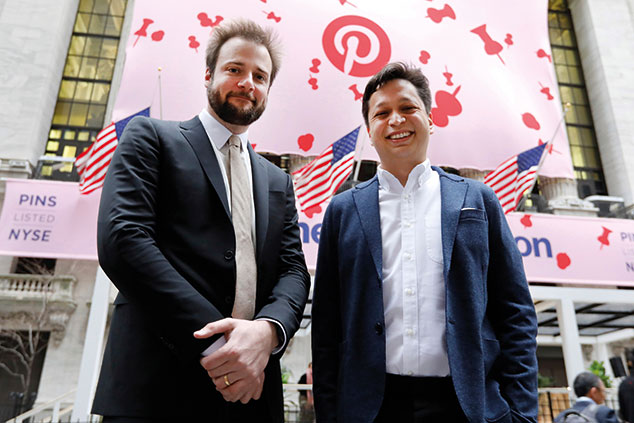
and Ben Silbermann: pride before a fall?
You might think that this sound like a rather flimsy premise for a company. There were also concerns that the poor performance of Lyft (one of Uber’s rivals) since its listing in March had dented investors’ enthusiasm for technology firms, resulting in Pinterest’s management initially saying that they would float it at $15-$17, below the valuation implied by the company’s last private funding round. However, investors have confounded expectations by piling in. Even before the stock went public a fortnight ago, Pinterest’s management revised the initial price to $19. Since then the shares have surged by half to just under $30.
Eye-wateringly expensive
This looks extremely expensive to me for several reasons. Firstly, like many technology companies that have been floated, or are about to float, Pinterest is not making any money yet. Indeed, Bloomberg analysts think that it may be another four years before it begins to make a consistent profit. Even if you think that immediate profitability is unimportant and prefer to concentrate solely on revenue – always a dangerous metric to rely on – Pinterest is still more expensive than most of its peers. It trades at more than 11- times 2020 sales. Etsy, Snap and Facebook sell for eight, seven-and-a-half, and six times next year’s sales respectively.
There’s also the possibility that it may not meet its ambitious sales targets, since revenue growth in the US is starting to slow. While growth outside the US is still robust, overseas markets comprise only a small proportion of sales. Another ominous sign is that many of its users tend to visit the site infrequently. Only a small proportion use it every week; many only once a month. Not only does this make it hard for Pinterest to entice advertisers, but it also means that it is vulnerable to its users deserting it for another website.
Of course, when you short technology companies that are currently seeing their share price surge, there is always the risk that their price could end up going higher. So I would wait until the price has fallen back a bit before pulling the trigger on the trade. In this case, you should only start shorting when it falls below $25. When this happens, you should short it at £200 per $1. With a stop-loss of $30, this should give you a total downside of £1,000.
Trading techniques… heed profit warnings
Profit warnings are an announcement, usually in the form of a press release, stating that earnings are going to be lower than the market is expecting. While there is no explicit legal requirement to issue a profit warning, companies that fail to do so may be vulnerable to being sued for market manipulation, and may find themselves facing a lot of angry shareholders.
It’s therefore no surprise that many companies tend to err on the side of caution, with 287 profit warnings issued by FTSE companies in 2018 alone, according to accountancy firm Ernst & Young. Profit warnings often have an immediate negative impact on share prices. However, there is evidence that shares that have experienced profit warnings continue to underperform in the weeks and months after the initial announcement.
For example, George Bulkley, Richard Harris and Renata Herrerias of the University of Exeter looked at the performance of 455 UK companies that issued profit warnings between August 1997 and the end of 1999. They found that not only did the share price immediately fall by an average of 16.7%, but it also lagged the market by a further 3.9% over the next six months.
Another study looked at firms that issued profit warnings and those that didn’t warn, but produced a nasty surprise with an earnings figure undershooting expectations. Jeffrey Doyle of the University of Utah, Russell Lundholm of the University of Michigan and Stanford’s Mark Soliman found that between 1988 and 2000 shares firms that warned continued to underperform after the earnings update, even if you bought them well after the news had come out. But buying shares in companies with positive earnings surprises was a good way to beat the market.
How my tips have fared
Over the past fortnight, five out of the eight long positions that I have tipped have increased. Greene King has gone up to 692p (from 664p), Cineworld has advanced to 321p (308p), Safestore has increased to 646p (627p), and Somero is now selling for 365p (360p).
Superdry has passed through the 500p barrier, triggering the trade, and is now at 534p. However, the biggest increase comes from JD Sports, which rose to 617p (520p). The only positions to decline are John Laing Group, down to 387p (from 399p), Hays, down to 153p (159p), and Bellway at 3,157p (3,174). In total my long tips are making a profit of £4,028.
My short tips have produced a much more mixed performance. Weis Markets has increased from $41.30 to $41.90.
Rightmove has gone up from 529p to 549p. However, Tesla has drifted down from $267.70 to $242. This means that my short tips are now losing a total of £112.
Overall, the 12 tips are making a collective profit of £3,916, the best performance since the column began, and easily more than the £1,829 in losses from the closed positions.
Despite the fact that the tips are doing well, I’m a bit worried that I’m currently tipping nine long positions and three shorts, which is rather unbalanced, especially as stockmarkets reach record valuations.
I’m therefore going to recommend that you close the position in Greene King. While it’s gone up by more than 50% in price, making us a profit of £932, it’s been just over a year since I first tipped it, which is a bit long to be holding a trading position.
I would further recommend that you lock in some profits by increasing the stop-loss on the Cineworld position, which I tipped six months ago, to 300p.